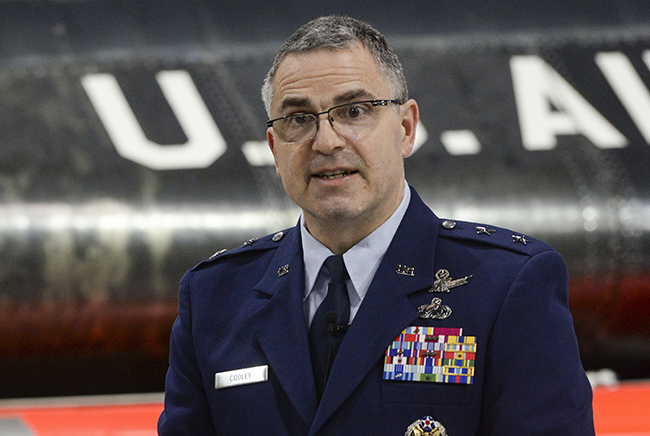
Maj. Gen. William Cooley, Air Force Research Laboratory commander, delivers remarks during a press conference inside the National Museum of the US Air Force at Wright-Patterson AFB, Ohio, on April 18, 2019. Air Force photo by Wesley Farnsworth.
The military’s advanced research laboratories and warfare centers turned the Pentagon courtyard into a science fair Thursday, highlighting advanced research into future weapons systems in an effort to bring each service’s efforts together.
The Pentagon launched the Lab Day event in 2015, and the 2019 version had more than 80 presentations on mission capabilities as big as hypersonic weapons and new directed energy efforts to new medical research.
Michael Griffin, under secretary of defense for research and engineering, said in kicking off the event that the laboratories are working “under pressure to go fast and fail fast.” While speed is important, it is necessary that the labs “remember our goal is, ultimately, mission impact.”
The Air Force Research Laboratory used the lab day to showcase several ongoing research and development programs focused on current and future USAF missions, including:
- Ongoing hypersonic flight research. AFRL highlighted the critical design review and future first flight of the X-60A liquid rocket, which will be a research vehicle used to understand the physics of hypersonic flight.
- An effort to use agile software development to integrate the many different methods of communication the Defense Department uses that, as of now, are not compatible out of the box.
- A high-power microwave system, using directed energy capabilities to help operate in a contested environment, including protecting against drone swarms.
- The Secure Live Virtual Constructive Advanced Training Environment program, an effort to field a live, virtual, and constructive training system to incorporate real-life flight training with computer-generated threats.
- A new probe that can accurately measure the thickness of robotically sprayed aircraft and spacecraft paint and primer materials.
- The Air Force Cognitive Engine, an effort to expand and operationalize artificial intelligence.
- The AgilePod, an AFRL-developed system to rapidly transfer sensors between aircraft.
AFRL Commander Maj. Gen. William Cooley said events like the Lab Day highlight the increasing effort to bridge research between military services. He has been meeting quarterly with the other services, along with the Defense Advanced Research Projects Agency and the US Coast Guard, to find ways to work together.
For example, each service has a vested interest in counter-unmanned aerial systems, but the Air Force has its own research, which it has worked with the Coast Guard, which looks to provide protection from the proliferating use of small drones.
“We are sharing that across our sister services, … and why not? Because we’re all on the same side…. There’s a time for natural rivalry and competition, and then there’s a time to say ‘OK, what are the capabilities that our warfighters, regardless of what uniform they’re wearing, actually need, and let’s get after that, and let’s get it deployed as rapidly as possible.”
